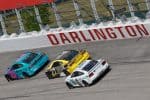The 1977 Southern 500 was one of the most storied NASCAR Cup Series races in the history of Darlington Raceway.
Not because it had a spectacular finish; David Pearson won by 2.5 seconds over Donnie Allison. They, along with Buddy Baker, were the only three drivers to complete all 367 laps. Not because Bill Elliott earned the first top-10 finish of what would become an outstanding career that would propel him into the NASCAR Hall of Fame.
Incidentally, Elliott’s Ford bore the No. 52, normally used by Jimmy Means. Elliott did Means a favor. Means was on NASCAR’s new plan money for independent, low-budget drivers, payable only to those who competed on the full schedule.
Means was unable to qualify and Elliott, who did not participate on a full schedule, agreed to use his number, which kept Means on the plan.
Not because a fledgling trade newspaper called Grand National Scene, which made its debut in April 1977, covered its first Southern 500 – something it did through 2009. OK, I admit that one is a purely personal opinion.
Rather, the race has significance because it spawned one of the longest and most notable – not to mention funny – driver feuds in NASCAR history.
In it, one competitor ridiculed the other’s intelligence and physical stamina. And the driver who did so was tagged with a nickname that hung with him for the remainder of his career.
Cale Yarborough came into the ’77 season seeking his second Cup championship with team owner Junior Johnson. Their first title together had been built on a 1976 season in which they earned nine victories and an astounding 23 top-10 finishes in 30 races.
In ’77, Darrell Waltrip was starting his third season with DiGard Racing Co., an outfit formed in Florida that had moved its operations to Charlotte.
During the first five years of his career, Waltrip won three races, all on short tracks. He was anxious to earn his first superspeedway victory. By the time the Southern 500 rolled around on Sept. 5, 1977, Waltrip had won three big track events ranging from Darlington in the spring to Talladega Superspeedway and Michigan International Speedway.
Both drivers were the favorites to win at Darlington. Now, Pearson got his due consideration considering he won 37 races on superspeedways since he joined the Wood Brothers in 1972. But he was in something of a slump. He won just two races in 1976, including the Southern 500, but by Labor Day in 1977, he had just one victory.
While it was somewhat successful, Waltrip’s association with DiGard had been bumpy. It was laced with bickering, complaining and unpleasant personnel changes. Despite the turmoil, Waltrip was expected to challenge Yarborough for the Southern 500 victory.
He won the pole and Yarborough started fourth. The two drivers put on an exciting display of racing, featuring some of the best competition ever seen at Darlington.
They swapped the lead repeatedly and with 100 laps remaining, Waltrip had led 11 times and Yarborough nine.
The two drivers approached traffic with just under 100 laps to go. Waltrip swooped around Yarborough going into the second turn and they roared down the backstretch – directly toward a group of lapped cars. With so little room to maneuver, it was clear one of them had to back off. But neither of the leaders cracked the throttle. That led to a five-car crash in the third turn.
Waltrip and Yarborough’s cars became hulks of crunched, smoking metal. Also involved in the mishap were the cars of D.K. Ulrich, Terry Bivins and Janet Guthrie. Remarkably, Waltrip and Yarborough continued to race, finishing sixth and fifth, respectively.
As the story goes, after the race, Yarborough was approached by Ulrich, who was inquisitive but not upset.
“Cale, he said, “you knocked the hell out of me in that turn. I thought I was out of the way, not in the high-speed groove. I thought there was plenty of room above me.”
To which Yarborough replied, “I didn’t hit you. In fact, I didn’t touch you. ‘Jaws’ hit you.”
“Who?” Ulrich asked.
Yarborough: “’Jaws’ Waltrip hit you and knocked you into the wall. Then you came off the wall and hit me. That’s what happened and it was totally uncalled for.”
When questioned by the media, Yarborough doubled down.
“‘Jaws’ ran into the back of a slower car and that’s what caused everything. Maybe that car shouldn’t have been in the way, but it was totally uncalled for. And you know who ‘Jaws’ is, don’t you? Yeah, that’s right. It’s ‘Jaws’ Waltrip.”
For his own part, Waltrip chose not to fire back. He was rather diplomatic.
“I know that in the movies, Jaws is a shark. And Jaws is also a character in a James Bond film,” he said. “But they are killers. I haven’t killed anybody.”
But in reality, he was laying in wait, ready to pounce when the opportunity arose.
It did three races later at Martinsville Speedway.
The Sept. 25 Old Dominion 500 was conducted in extremely hot, humid weather. The track temperature was exceedingly high and it was the same in the cars. Throughout the race, several competitors had to take on relief drivers.
Yarborough won the race for his ninth victory of the year. But he was anything but happy when it was over.
“Something has to be done,” said an exhausted, sweaty and red-faced Yarborough. “The length of these races has to be shortened. It’s very bad for the drivers. It’s getting so they are more dangerous than actual racing. This is absolutely the worst physical beating I have ever taken.”
Waltrip had the ammunition he needed. As fate would have it, he won the very next race, the Wilkes 400 at the half-mile North Wilkesboro Speedway.
To win his fifth race of the season, Waltrip had to pass Yarborough in the closing laps. And, like Martinsville, the event was run in hot, humid weather.
“Well,” Waltrip said with a grin on his face, “this was a hot day. I reckon it was a one and a half or two on the ‘Cale Scale.’ I mean, ol’ Cale doesn’t appear to be nearly as tuckered out as he was a week ago. I think his problem may be his years. He’s 38 and I’m 30 and gee, I am discovering there are things I can’t do now that I could 10 years ago. Could be Cale is finding that it’s the same for him.”
The feud became part of the character of the 1977 season. Everyone knew about it.
The late Humpy Wheeler, known for his outlandish promotions at Charlotte Motor Speedway, staged a chicken plucking contest – yes, you read that right – during the week prior to the Oct. 9 NAPA National 500.
On display at the event was a dead shark mounted on a pole with a chicken in its mouth. Yarborough’s sponsor was Holly Farms Chicken. Of course, everyone knew what that represented. In time, sharp words between Waltrip and Yarborough faded away, although it was fairly certain they wouldn’t be having dinner together.
But the feud is remembered by many to this day.
If you’re ever on pit road or in a garage area at a NASCAR speedway – or just about anywhere else, for that matter – ask around if anyone knows who “Jaws” was.
You’ll get the answer. And it won’t take long.
Steve Waid has been in journalism since 1972, when he began his newspaper career at the Martinsville (Va.) Bulletin. He has spent over 40 years in motorsports journalism, first with the Roanoke Times-World News and later as publisher and vice president for NASCAR Scene and NASCAR Illustrated.
Steve has won numerous state sports writing awards and several more from the National Motorsports Press Association for his motorsports coverage, feature and column writing. For several years, Steve was a regular on “NASCAR This Morning” on FOX Sports Net and he is the co-author, with Tom Higgins, of the biography “Junior Johnson: Brave In Life.”
In January 2014, Steve was inducted into the NMPA Hall of Fame. And in 2019 he was presented the Squier-Hall Award by the NASCAR Hall of Fame for lifetime excellence in motorsports journalism. In addition to writing for Frontstretch, Steve is also the co-host of The Scene Vault Podcast.





